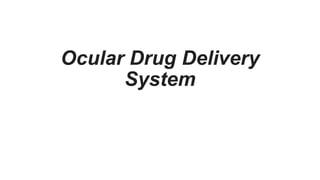This document discusses ocular drug delivery systems. It begins by defining an ocular drug delivery system as a novel approach where drugs are instilled in the eye's cul-de-sac cavity. It then describes the anatomy and barriers of the eye, including the anterior and posterior segments, tear film, and blood-ocular barriers. Various ocular drug delivery formulations are discussed such as inserts, vesicles, and controlled release systems. Barriers to ocular drug delivery like drainage, absorption, and permeability are outlined along with methods to overcome them like intravitreal injections. Ideal characteristics and factors affecting bioavailability of ocular delivery systems are also summarized.










































